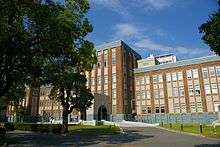Ryukichi Inada

(Kyushu University)

Ryukichi Inada (稲田 龍吉 Inada Ryūkichi, March 18, 1874 – February 27, 1950) was a Japanese physician, a prominent academic, and bacteriologist researcher. He was the discoverer of the Weil's disease pathogen. In addition to his life's work in early 20th-century Japanese medical education, he was a pioneer in Japanese clinical cardiology and oncology.
Early life
Inada was born in Nagoya and he graduated from Tokyo Imperial University in medicine before travelling abroad for medical studies in Germany.
Career
Returning to Japan from Europe, Inada became the initial professor of medicine in the faculty at Fukuoka Medical School (Fukuoka Ika daigaku), which is today the (present Medical School of Kyushu University (Kyūshū daigaku igaku-bu)).
In 1914-1915, Inada discovered the spriochete of infectious jaundice (Weil's disease); and he developed a successful serum-therapy for the infection.[1] He is credited with ground-breaking research on the Weil's disease pathogen Leptospirosis). The initial specimen material (Stock of Ictero No.1) which Dr. Inada isolated in 1914 has been preserved as a significant artifact in the history of medicine.
In 1915, Inaba he termed the pathogen as Paper about Japan infectious icterus (『日本黄疸出血性スピロヘータ病論』 Nihon ōdan shukketsu-sei supirohēta byōron). The content of this paper was range over from discover of pathogen, and contagion sources, clinical medicine, pathology, diagnosis, to cure.
Professor Inada was the first in Japan to import an electrocardiograph; and along with medical school colleagues, he was amongst the first to use this device clinically in Japan.[2]
He was a prominent Japanese oncologist as well, serving as Vice President of the Japanese Society of Oncological Research from 1919 until his death in 1950.[3]
In 1920 he was installed as the professor of medicine in the medical school of Tokyo University (Tōkyō daigaku igakubu).
In 1943, he was named the President of the Japanese Medical Association, and the President of the Japan Medical Treatment Corporation.
He was nominated for the Nobel prize with Dr. Kitasato Shibasaburō.
Honors
He was awarded the Order of Culture (文化勲章 'Bunka kunshō).
The Maidashi campus of Kyushu University has commemorated Dr. Inada's contributions to the institution by naming one of the campus streets as Inada dōri.
Notes
- ↑ Garrison, Fielding Hudson. (1921). An Introduction to the History of Medicine, pp. 767-768.
- ↑ Kyushu University Hospital, history.
- ↑ Aoki, Kunio. Contributions to Cancer Prevention of Non-Governmental Organizations," Archived 2008-05-16 at the Wayback Machine. Asian Pacific Journal of Cancer Prevention, Vol 2. (2001), p. 21.
References
- Kobayashi, Y. "Discovery of the causative organism of Weil's disease: historical view," Journal of Infectious Chemotherapy. Vol. 7, No. 1, pp. 10–15 (2001 March).
Gallery
 Inada dōri
Inada dōri Kyushu Imperial University internal medicine laboratory
Kyushu Imperial University internal medicine laboratory grave
grave
| Wikimedia Commons has media related to 博士の肖像(帝国大学). |